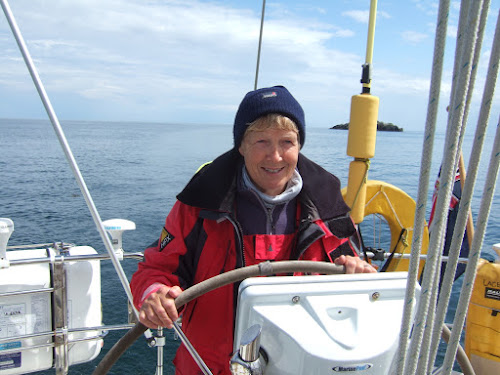On Friday the strong winds had died down and, with a Westerly force 3 and bright sunshine we filled with diesel and left Whitehills bound for Peterhead. For a couple of hours we sailed with full sail, the genoa boomed out opposite the mainsail, dipping into the bays along the coast to keep out of the west going tide, sometimes picking up a back eddy pushing us along.
Off Troup Head we at last managed to photograph gannets taking off and in flight. The cliffs were thick with seabirds with more on the water, a fantastic sight.
Approaching Fraserburgh the wind dropped enough for us to need the engine on then, as we turned South, sprang up again from the East allowing us to sail for a while. As we approached Rattray Head the wind veered to the South with ominous rain clouds building up so the engine went back on and we motored for the next hour and a half to Peterhead.
Peterhead harbour is a busy port and was full of offshore supply ships. We reported in for permission to enter and headed into the marina, tucked away in the South West corner. Our stay in Peterhead was only short as we needed an early start next morning for the 120 mile leg to Port Edgar, located between the new (under construction) and old Forth road bridges. We were lucky enough to see an air display over the harbour, celebrating the end of Peterhead Scottish week, set up to promote trade and tourism. Apparently Peterhead is the only Scottish town to do this.
To make the most of the South going tide would have meant an early, circa 0500, start but would have meant that we got to Port Edgar in the dark so we opted for a slightly later 0700 start, eventually getting away at 0720 with an eta Port Edgar 0430 the following day. Outside the harbour we were greeted by a NNE 14 knot breeze so the engine quickly went off and the spinnaker went up. We needed to maintain this course for the next 78 miles! As with a number of our passages this was not to be. After nearly 3 hours we were off Aberdeen and the wind dropped, forcing us to drop the spinnaker and go for the engine again.
For the rest of the trip the wind remained light and what there was came from the SW! The only plus being that the autopilot could do all the steering. With a route set on the plotter we didn't need to touch the helm until we were approaching the Forth Rail bridge! Eventually rain set in so we put the sprayhood up to give whoever was on watch somewhere to lurk but still see what was going on. We experimented with collecting rainwater off the end of the boom and easily collected a couple of litres in a matter of minutes. We won't run short of water as long as we remain in Scottish waters! We were in the outer Forth by the time it got dark, plenty of lights to check on our position but also a few ships to keep an eye on. I had one panic when the AIS said that the CPA (closest point of approach) of a pilot boat was 10 feet! Fortunately the pilot was heading for a cruise ship in front of us and stopped before getting anywhere near us! By 0530 we passed under the iconic railway bridge and found ourselves an empty berth tucked well into the marina (the outer berths are subject to swell and wash from passing ships) and put our heads down for a few hours kip.
We had 2 reasons for visiting Port Edgar. One was to meet up with daughter Robyn, who had been in the South all week, and could use Port Edgar as a stop off point on her way home. Due to traffic she was quite late getting to us but it was still nice to have an hour with her before she had to be on her way again.
The second reason was to meet our old friends Kay and Jock Blair, who used to own and run The Bosun's Locker chandlery in the marina and also built the hull of our E Boat, our first foray into keelboats in 1980. Jock and Debbie first met in 1973 sailing Fireballs at Stonehaven. Kay and Jock came aboard for tea on Monday morning and invited us to dinner and a bed in a house, luxury and not to be turned down lightly! So a pleasant evening was passed reminiscing and sharing stories over a couple of bottles of wine finishing with a glass or two of malt.
Jock returned us, slightly jaded, to the boat on Tuesday morning. We are now on passage to Eyemouth, 50 miles away and our last port in Scotland. No wind so the engine is working for its living again.


















































